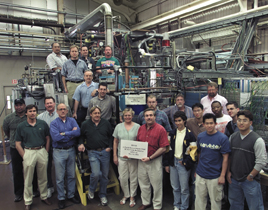The ancient Greek philosopher and scientist Aristotle told of Greeks living in the city of Magnesia who had discovered a most unusual stone with the power to attract iron. William Gilbert, physician to Queen Elizabeth I of England, produced the first accurate theory on magnetism in 1600 with the publication of his book which described the Earth as a giant magnet. Two centuries later, English physicist Michael Faraday became the first to produce an electric current from a magnetic field, laying the groundwork for Scottish physicist James Clerk Maxwell's electromagnetic field theory a few years later.
Imagine what Aristotle, Gilbert, Faraday, Maxwell, and all the other great scientists and engineers who contributed to the development of magnets and magnetic technology would think about this: Berkeley Lab researchers in the Superconducting Magnet Group shattered the world-record in magnetic field-strength when their newest niobium-tin dipole electromagnet reached 14.7 Tesla. How strong is it? 14.7 Tesla is better than 300,000 times the strength of Earth's magnetic field.
| "We're always looking forward. After we reach 15 Tesla, we'll aim for 16 Tesla." | |||
"Our job is to push the technology envelope as far as we can in terms of high magnetic field-strength and that is what we did," said Steve Gourlay, a physicist with the Accelerator and Fusion Research Division (AFRD) who lead the team that designed and built the magnet known as RD-3.
The new world record-holding magnet is one-meter long and weighs several tons. It consists of three magnetic coil modules (a double-pancake outer and single-layer inner) which were wound from more than eight miles worth of niobium-tin wire. The previous record field strength for a dipole electromagnet was 13.5 Tesla. That record was set in 1997 by a niobium-tin electromagnet called D20 which was also designed and built here at Berkeley Lab.
|
|
||
| Members of the Berkeley Lab team that designed and built the record-shattering RD-3 magnet pose in front of it. | ||
Members of the new record-holding team in addition to Gourlay were Robert Benjegerdes, Paul Bish, Doyle Byford, Shlomo Caspi, Daniel Dietderich, Ray Hafalia, Charles Hannaford, Hugh Higley, Alan Jackson, Alan Lietzke, Nate Liggins, Alfred McInturff, Jim O'Neil, Evan Palmerston, GianLuca Sabbi, Ron Scanlan, and James Swanson.
Dipole magnets are used to bend and maintain the path of accelerating particle beams. The higher the field strengths of the magnets, the tighter the arc of the beam. With stronger dipole magnets, an accelerator can push particles to much higher relativistic energies around the same-sized circular beam path.
"We're charged with developing superconducting magnet technology that not only yields high field-strength but is also cost-effective for the next generation of accelerators," says Gourlay. "To achieve this, we have been working with a niobium-tin superconductor (Nb3Sn) and emphasizing simplicity in our design."
The design Gourlay and his colleagues employed was centered around a "common-coil racetrack" geometry, an idea that originated at Brookhaven National Laboratory, in which a pair of coils shaped like an oval racetrack are shared between two apertures to produce opposing magnetic fields.
Berkeley Lab's Superconducting Magnet Group is now planning the design of a magnet that should reach a field strength of 15 Tesla.
"We're always looking forward," says Gourlay. "After we reach 15 Tesla, we'll aim for 16 Tesla." - end -
|
|||||||||
